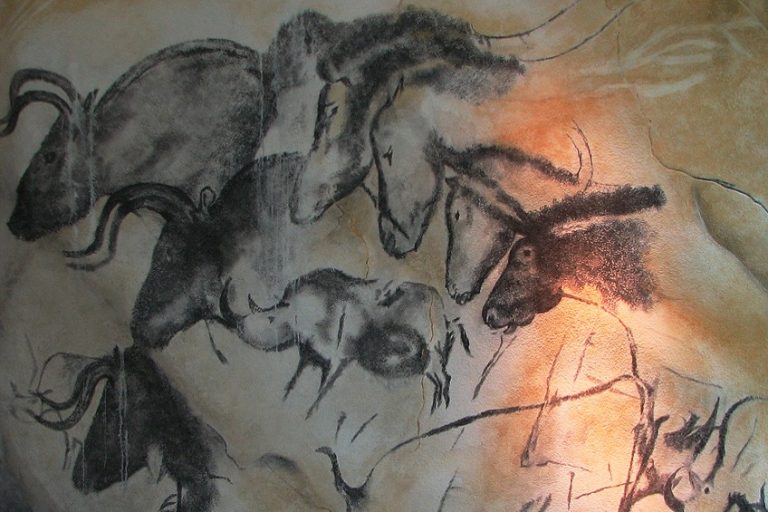Famous Gothic Paintings – Top 10 Gothic Period Masterpieces
Gothic art, which was a style in Medieval Art, developed some time during the 12th century. While the majority of the artworks that came from this genre were architectural designs, such as cathedrals and stained-glass windows, as well as sculptures and illuminated manuscripts, some notable panel paintings and frescos were also produced. A few key artists stood out during Gothic period art as they created the most well-known paintings. Today, most of the examples of famous Gothic art detailed below exist as notable pieces in art history.
Table of Contents
- 1 What Was the Gothic Art Movement?
- 2 Our Top 10 Most Famous Gothic Paintings
- 2.1 Maestà di Santa Trinita (1283-1291) by Cimabue
- 2.2 The Rucellai Madonna (1285) by Duccio
- 2.3 The Flight into Egypt (1304-1306) by Giotto
- 2.4 Adoration of the Magi (1305) by Giotto
- 2.5 Lamentation (The Mourning of Christ) (1306) by Giotto
- 2.6 Ognissanti Madonna (1306) by Giotto
- 2.7 Maestà del Duomo di Siena (1308-1311) by Duccio
- 2.8 Annunciation with St. Margaret and St. Ansanus (1333) by Simone Martini and Lippo Memmi
- 2.9 Coronation of the Virgin (1432) by Fra Angelico
- 2.10 Madonna with Child (1480) by Carlo Crivelli
What Was the Gothic Art Movement?
Also known simply as Goth art, this movement emerged in Northern France after the start of the Romanesque period of art in the early 12th century. Spreading quickly throughout Western Europe and much of Central, Northern, and Southern Europe as well, Gothic art demonstrated the style’s immediate popularity upon its arrival. The main artform to come from this period of art was Gothic architecture, which developed alongside the progression of general Gothic artwork.
Italy proved to be initially unaffected by this new style, as artists within the country were still strongly influenced by Byzantine art techniques during this period. The transition from Byzantine-inspired Romanesque art to Gothic art was thus a slow one, with only subtle hints of Gothic elements showing up in small areas like ornamental detailing at first.
Cimabue and Duccio, who were considered to be two of the greatest Italian painters of the Middle Age, were the first artists to visibly break away from the Byzantine art form in favor of Gothic art.

Due to the vast contributions of Cimabue and Duccio, they went on to pioneer in the further development of famous Gothic art. They eventually worked under Giotto, who went on to develop and influence even more realistic characters in his works. By the second half of the 13th century, Italian Gothic painting finally began to prosper on its own accord. The artworks produced showcased a more direct move towards naturalism, as paintings and sculptures portrayed figures with more lifelike dimensions, expressions, and shading.
Painting during the Gothic period was exhibited in four main styles that included panel painting, frescos, manuscript illumination, and stained glass.
Certain techniques began to develop, such as the use of foreshortening and chiaroscuro in order to represent very evocative figures. As the style grew in popularity, Gothic paintings in the form of frescos were replaced by large multicolored stained-glass windows in churches and cathedrals. Thus, the most famous Gothic paintings known today formed part of these architectural structures.
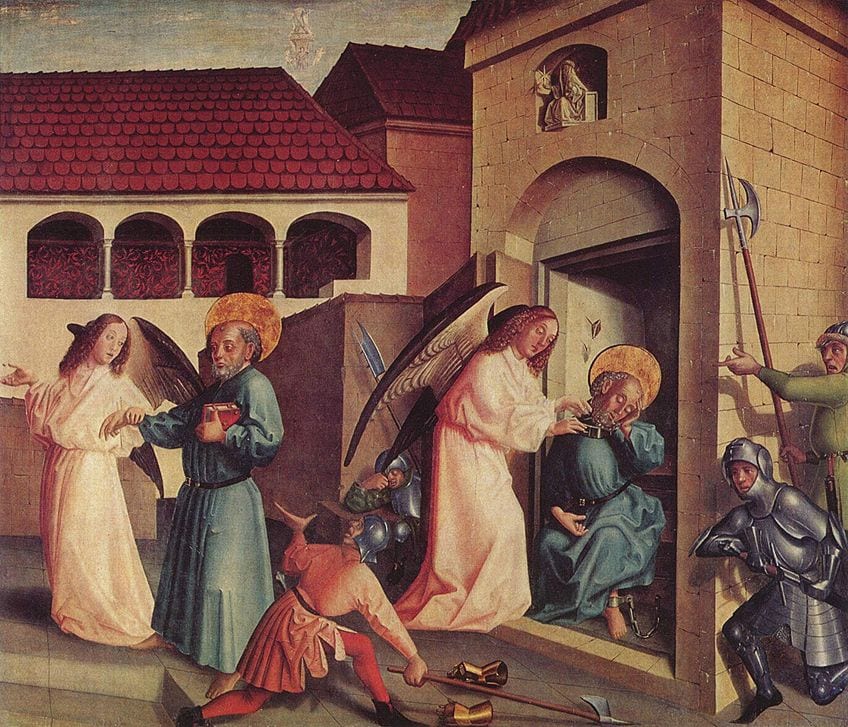
Our Top 10 Most Famous Gothic Paintings
The Gothic art movement proved to be very influential, as it led to the creation of some of the most beautifully crafted works in art history. The majority of the famous Gothic art pieces that exist were made with a heavily religious tone, as their purpose was to be placed in a church, cathedral, or monastery.
While many equally significant paintings and even more sculptures can be considered, we will be taking a look at the top 10 most famous Gothic paintings of all time.
Maestà di Santa Trinita (1283-1291) by Cimabue
| Artist | Cimabue |
| Date Painted | 1283 – 1291 |
| Medium | Tempera on panel |
| Dimensions | 385 cm x 223 cm (152 in x 88 in) |
| Where It Is Currently Housed | Uffizi Gallery, Florence |
Italian Medieval artist Cimabue painted the Maestà di Santa Trinita originally for the Santa Trinita church in Florence, where it remained until it was excavated to be housed in the official Uffizi gallery. Considered to be a Gothic painting with noticeable elements of the Renaissance, the Maestà di Santa Trinita represented the Madonna and Child sitting on a golden throne implied to be in Heaven.
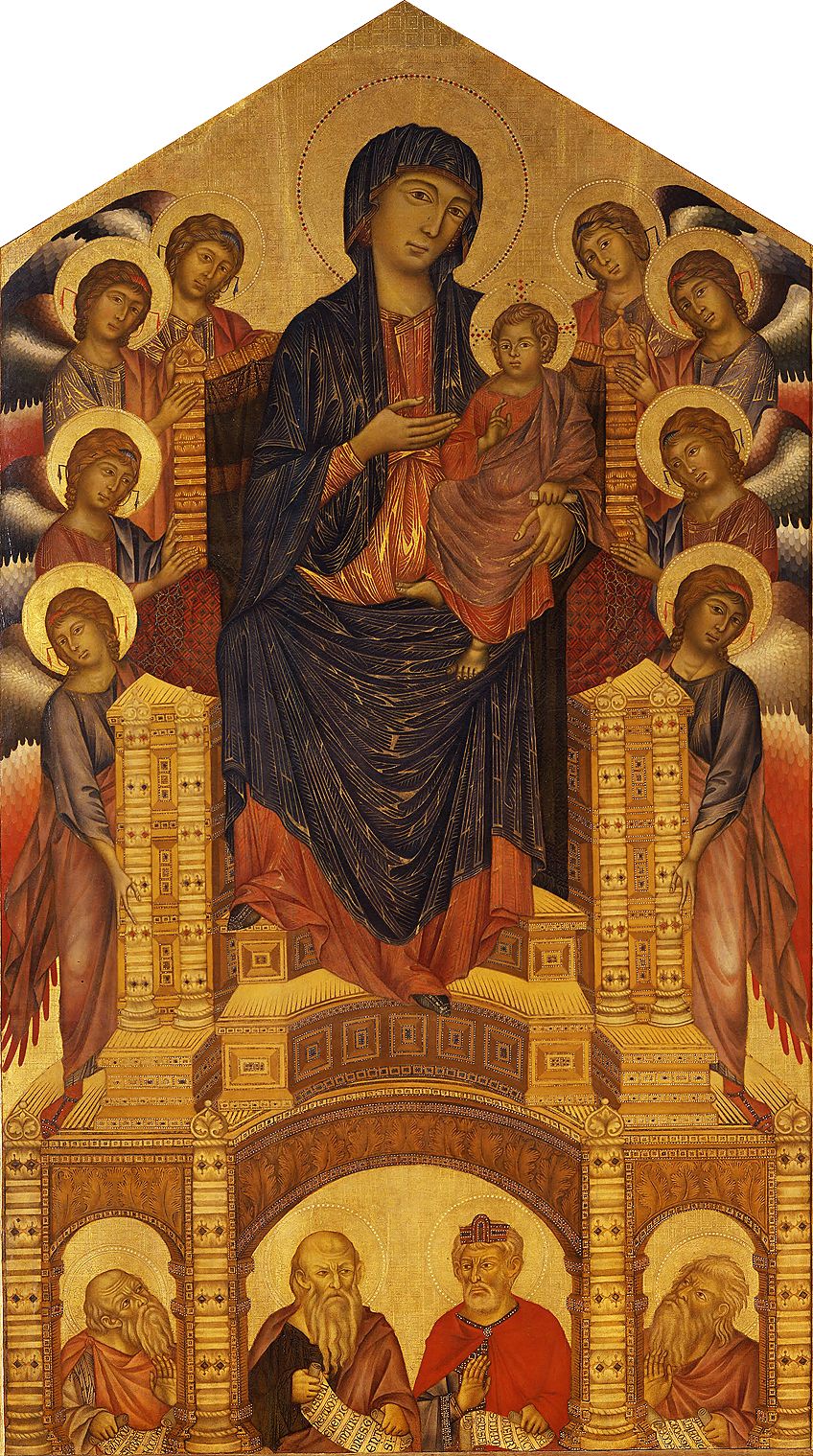
Four angels are represented on either side of the Madonna in a symmetrical design, as they are all shown to be holding the towers as if in support. Only the two angels at the very top have their faces turned towards her, while the rest look elsewhere. As the angels overlap, their wings form a pattern that seems to be graded according to color, which helps lead viewers’ eyes upwards to focus on the Madonna in a way that emphasized their importance.
Below this heavenly depiction, the portrait of four important prophets was included, who look out through three arches. Their insertion helped to covey the authority and power associated with tradition. Within Maestà di Santa Trinita, Cimabue demonstrated a noticeable move away from the flat representations and stylized figures of the Byzantine style.
This was seen through the addition of movement within this work, with Cimabue attempting to add motion through the naturalistic draping of the Madonna’s clothing.
The Rucellai Madonna (1285) by Duccio
| Artist | Duccio |
| Date Painted | 1285 |
| Medium | Tempera on gold and panel |
| Dimensions | 450 cm x 290 cm (180 in x 110 in) |
| Where It Is Currently Housed | Uffizi Gallery, Florence |
The Rucellai Madonna exists as the oldest and most well-known work painted by the Gothic artist Duccio. It was originally commissioned for the church of Santa Maria Novella in Florence by the community that regularly met at the church to sing the praises of the Madonna. In 1591, it was moved to the larger Rucellai family chapel before being transferred to the Uffizi Gallery at the start of the 19th century.
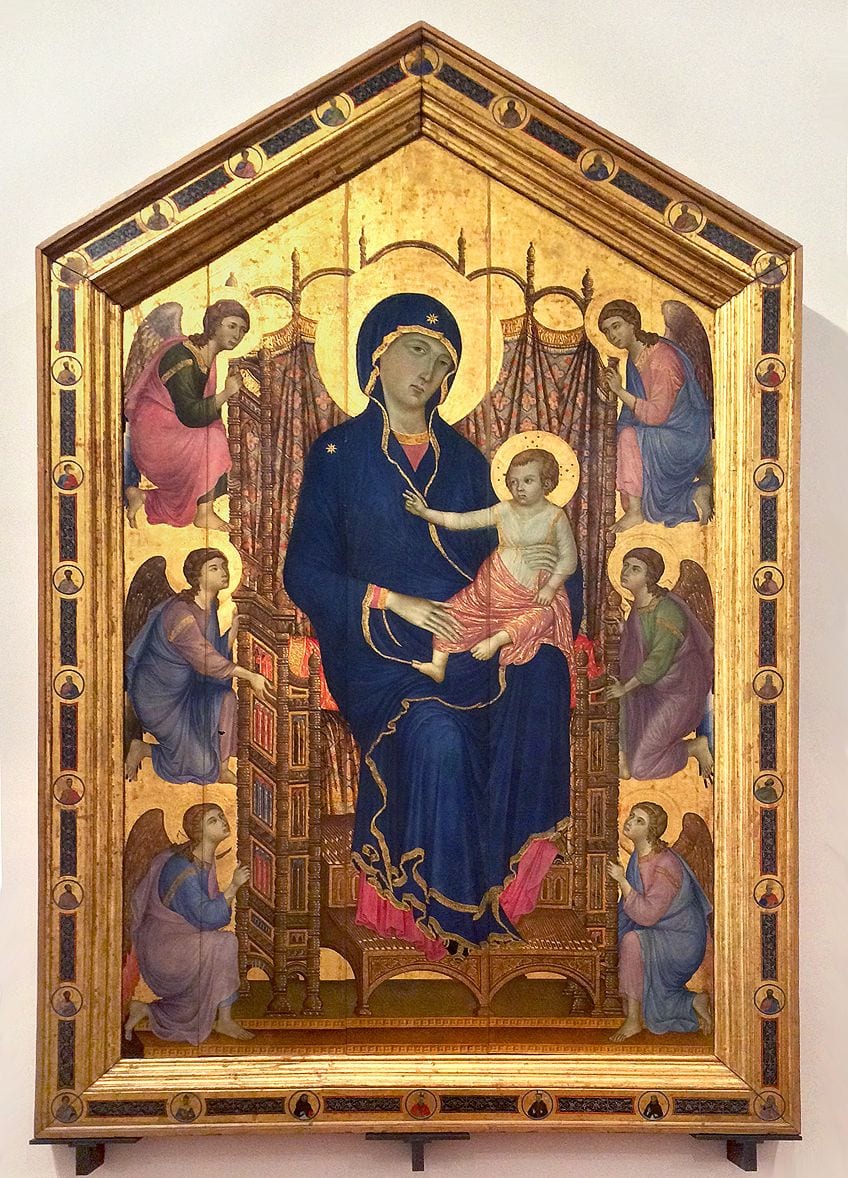
Known as the largest 13th-century panel painting in history, The Rucellai Madonna depicts the Virgin and Child sitting upon a golden throne that is surrounded by six angels. Her shoulders are shown to be covered by a banner, which symbolized her honor and reputation, while the Christ Child wears customary ancient red and gold robes around his waist. With his right hand extended, the Christ Child was said to be bestowing a blessing.
Each of the six angels appears to be kneeling where they are, which gives the impression that they are temporarily suspended in time.
This was thought to be because The Rucellai Madonna was considered a manifestation of the holy image that was typically seen by worshippers. The sideways angle of the throne, as well as the slightly slanted position of the Virgin, demonstrates a technique frequently used by artists during the 13th century to add the element of spatial depth to their paintings.
The Flight into Egypt (1304-1306) by Giotto
| Artist | Giotto |
| Date Painted | 1304 – 1306 |
| Medium | Fresco |
| Dimensions | 200 cm x 185 cm (78 in x 73 in) |
| Where It Is Currently Housed | Scrovegni Chapel, Padua, Italy |
Iconic Italian artist Giotto painted many incredibly well-known artworks that are still spoken about today. With his style overlapping between late Goth art and the Proto-Renaissance, a mixture of techniques can be seen in his paintings. One of his significant frescos includes The Flight into Egypt, which was based on the Bible story taken from Matthew 2:13 – 23. Currently, it can still be visited at the Scrovegni Chapel in Italy
Giotto’s painting represented the flight into Egypt, whereby Joseph fled to Egypt with Mary and their son, Jesus, after being visited by three kings known as the Magi. The story goes that after this visit, an angel appeared to Joseph in his dream telling him to leave, as King Herod was planning on killing the baby. While Giotto labeled his painting with the term “flight”, viewers instead see a slow procession taking place in the desert.
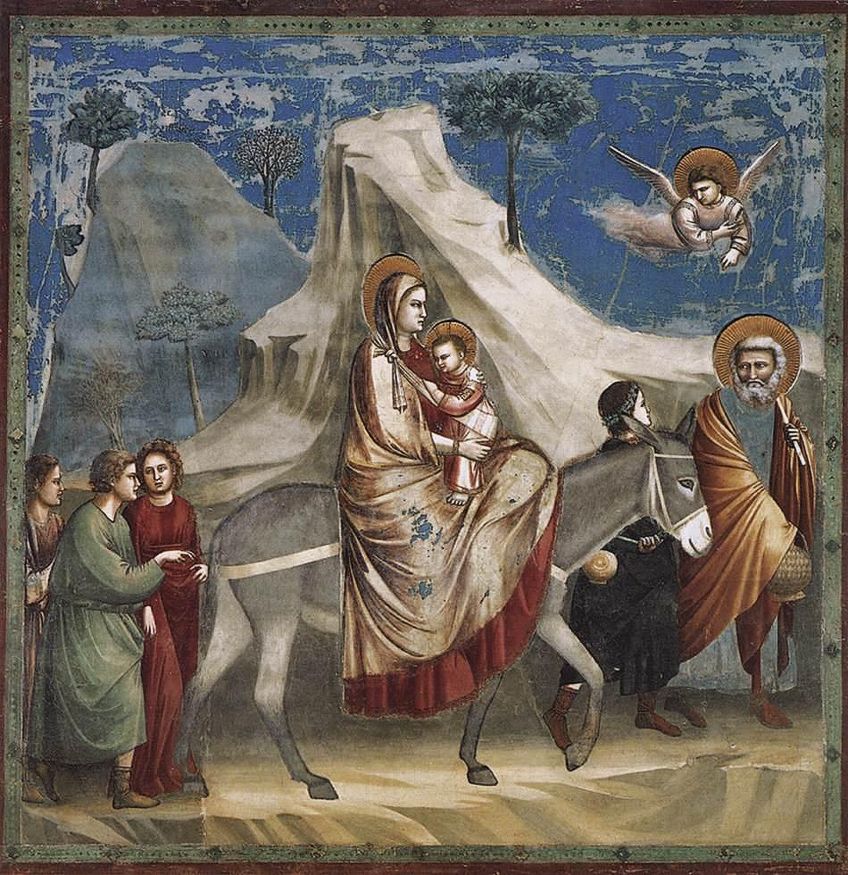
As the figures are shown to be moving with haste, the impression is created that this journey is very important.
Through the delicate composition created, Giotto purposefully placed both the individuals and animals within his painting. The donkey, upon which Mary and Jesus sit, is shown to represent the base of the pyramid in the background, while Mary and her son appear as the pinnacle of the structure. The inclusion of the donkey demonstrated the humbleness with which Jesus Christ emerged in the world. Shown as merely a defenseless baby sitting on the humblest of animals, The Flight of Egypt portrays their search for refuge.
Adoration of the Magi (1305) by Giotto
| Artist | Giotto |
| Date Painted | 1305 |
| Medium | Fresco |
| Dimensions | 200 cm x 185 cm (78 in x 73 in) |
| Where It Is Currently Housed | Scrovegni Chapel, Padua, Italy |
Another famous Gothic art piece created by Giotto was Adoration of the Magi, which was also located in the Scrovegni chapel in Italy. This painting belongs to a series of seven other paintings that represent the life of Christ and were all painted by Giotto. The Adoration of the Magi is traditionally a title given to the subject in the Nativity of Jesus, which represents the three Magi who traveled to Bethlehem to visit the infant.

Giotto modeled this fresco after the Biblical story of the Three Wise Men who visited baby Jesus and bestowed onto him gifts of gold, frankincense, and myrrh. As many different depictions of this story have been seen in art throughout the decade, Giotto’s Adoration of the Magi exists as a vivid yet gentle rendering of the story.
When it was first painted, the sky was depicted with a vibrant blue that emphasized the Star of Bethlehem, represented by the shooting comet in the middle of the sky thought to resemble Halley’s comet.
The only other bright color seen within Giotto’s work is the burgundy red of Mary’s dress, which contrasted greatly against the beiges and whites worn by the other figures. This was also used to draw attention to her when viewing the work as the subject of the fresco, which was baby Jesus, is seen sitting on her lap. Additionally, the simplicity used to portray the crib and background enable the insignificant elements to blend away, until only the most important aspects are focused on.
Lamentation (The Mourning of Christ) (1306) by Giotto
| Artist | Giotto |
| Date Painted | 1306 |
| Medium | Fresco |
| Dimensions | 200 cm x 185 cm (79 in x 73 in) |
| Where It Is Currently Housed | Scrovegni Chapel, Padua, Italy |
The third famous Gothic art piece created by Giotto and located in the Scrovegni chapel is Lamentation (The Mourning of Christ). This painting formed part of the larger fresco that was commissioned by Enrico Scrovegni to be his funerary monument and a form of atonement for his father’s sins committed in the Catholic church.
This late Gothic artwork depicts the grieving of Christ, as he is supported by his mother while Mary Magdalene grips his feet and other lamenters encircle him.
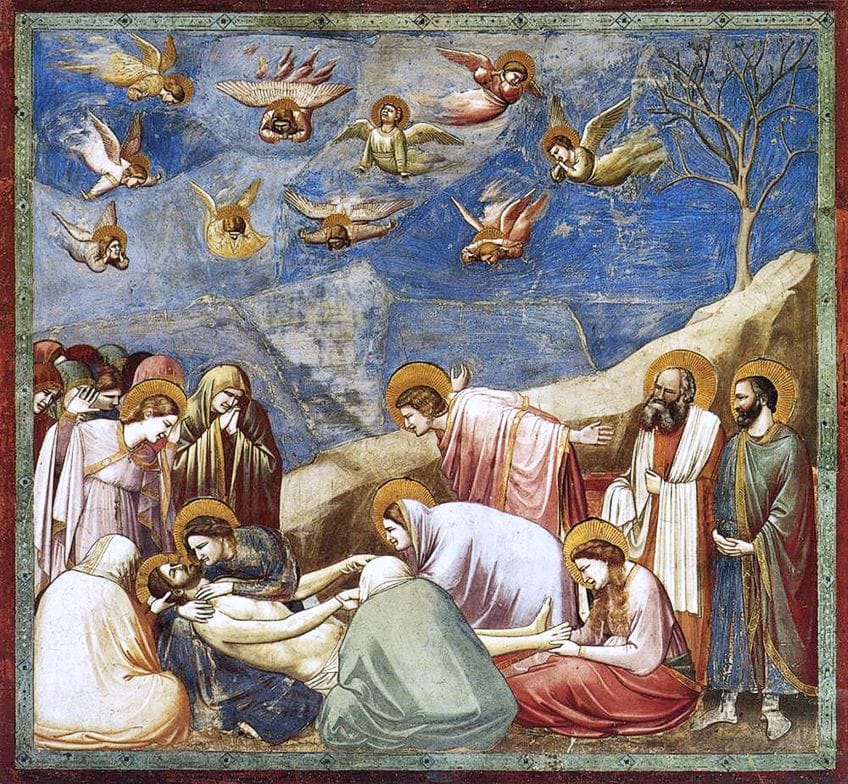
As multiple angels are seen flying above Christ, two apostles are depicted to be standing beside the stone wall that effectively separated the human scene from the heavens. The posture of the angels, as well as their drooped wings, convey their divine stress at the situation they are witnessing. The composition designed by Giotto helped to emphasize the dead Christ’s face as the focal point, as the faces of all the individuals are turned towards him.
Giotto’s treatment of human emotion as a realistic and powerful tool is evident in Lamentation (The Mourning of Christ). Both the body language and the facial expressions of the mourners convey their deep anguish and grief at the death of Christ, with a very somber scene being portrayed.
Ognissanti Madonna (1306) by Giotto
| Artist | Giotto |
| Date Painted | 1306 |
| Medium | Tempera on panel |
| Dimensions | 325 cm x 204 cm (128 in x 80 in) |
| Where It Is Currently Housed | Uffizi Gallery, Florence |
The final artwork created by Giotto that we have included on our list is his Ognissanti Madonna, which is known to be a very important landmark in the history of art. Made to be a large altarpiece, Ognissanti Madonna was painted for the Church of Ognissanti in Florence, which is where it got its name from. As history has gone on, this painting has also been known under the name Madonna Enthroned.

Following a very traditional Christian subject matter, Giotto painted the Virgin Mary with the Christ Child seated on her lap, surrounded by both angels and saints. This particular depiction of the Virgin Mary was called “Maestà”, which proved to be a very popular version at the time. This representation can be seen in Cimabue’s Maestà di Santa Trinita (1283 – 1291).
Giotto portrayed the Virgin Mary and Child as solid, well-defined figures who appeared to be firmly grounded upon the throne. They were also painted in a more plausibly and humanly way, which demonstrated his move away from flat surfaces. By placing Mary on the throne, Giotto’s quest for perspective is shown, as her presence on the chair helped to convey the idea of an actual environment.
Additionally, the folds in the garments worn by all the figures insert motion into the work, which exists as another acknowledgment of reality.
Maestà del Duomo di Siena (1308-1311) by Duccio
| Artist | Duccio |
| Date Painted | 1308 – 1311 |
| Medium | Tempera and gold on wood |
| Dimensions | 213 cm x 396 cm (84 in x 156 in) |
| Where It Is Currently Housed | Museo dell ‘Opera Metropolitana del Duomo, Spain |
Among the many famous Gothic paintings created by Duccio is his Maestà del Duomo di Siena, which was commissioned by the city of Siena, Italy in 1308. This painting exists as the most significant piece of his career, as it is arguably the greatest panel painting that has ever been produced.
This double-sided alter piece depicted a large Madonna and Child sitting on a throne on the front panels, who are surrounded on both sides by many saints and angels on the adjoining panels.
Following in the footsteps of many other artworks that made use of the Virgin Mary and Child during the 14th century, Duccio’s painting is by far the most beautiful and extravagant one to ever be painted. Once again, Madonna and Child are depicted to be firmly seated on the golden throne, which helped to focus attention on them as the main focal points of the painting.

Duccio included a predella beneath the painting, which depicted seven scenes taken from the childhood of Christ. Above the middle panel, peaks of the life of the Virgin Mary were also portrayed, while the entire back of the painting was covered in various scenes from Christ’s life.
Today, the main panel can be found at the Museo dell ‘Opera Metropolitana del Duomo in Siena, while other panels from the altarpiece are located at the National Gallery in London the Frick Collection in New York, and the National Gallery of Art in Washington D.C.
Annunciation with St. Margaret and St. Ansanus (1333) by Simone Martini and Lippo Memmi
| Artist | Simone Martini and Lippo Memmi |
| Date Painted | 1333 |
| Medium | Tempera and gold on panel |
| Dimensions | 305 cm x 265 cm (120 in x 104 in) |
| Where It Is Currently Housed | Uffizi Gallery, Florence |
The Annunciation with St. Margaret and St. Ansanus was painted by Italian Gothic artists Simone Martini and Lippo Memmi and was originally intended for the side altar in the Siena Cathedral. The central panel is thought to be one of Martini’s masterpieces, as it showed his groundbreaking use of line merged with a feeling of motion and human expression. In addition to the prophets, Memmi was said to have painted St. Margaret on the far right and St. Ansanus on the left, despite his works lacking the sophistication of Martini’s.
Within the central panel, which is widely considered to be the most important aspect of the work, the Annunciation is portrayed.

Archangel Gabriel, carrying an olive branch, is depicted to be kneeling before Mary, who is identified on the right side of the panel by her dark robes. Gabriel was said to be informing her that she would shortly be in labor with the son of God. However, Mary’s face is depicted with an expression of disbelief, as she seems to be recoiling from the announcement.
In between these two figures, a vase of lilies can be seen, which was said to symbolize purity. Above them, a group of angels interlacing their wings, with the Latin words “Hail, Mary, full of grace, the Lord is with thee” is seen. These works are embossed in a diagonal line reaching from the lips of the angels towards Mary.
Coronation of the Virgin (1432) by Fra Angelico
| Artist | Fra Angelico |
| Date Painted | 1432 |
| Medium | Tempera on panel |
| Dimensions | 112 cm x 114 cm (44 in x 45 in) |
| Where It Is Currently Housed | Uffizi Gallery, Florence |
Another famous Gothic artist was Fra Angelico, who painted Coronation of the Virgin. Angelico went on to paint another identical artwork between 1434 and 1435, also titled Coronation of the Virgin, which can be found in the Louvre Museum in Paris today. During the early Gothic period, the coronation of Mary was among the common subjects depicted by artists, with this painting proving no different.

Within this Gothic painting, which has a gilded background, a Coronation above paradise is portrayed by Angelico. In the center of the work, Christ can be seen crowning the Virgin. Both of these figures are being surrounded by brilliant rays of sunlight, which were used to symbolize the divine light.
Similar to other paintings and Gothic drawings produced by Angelica, this artwork has a mystical tone to it.
Beneath Christ and the Virgin Mary, a big crowd of saints, angels, and other blessed figures are shown, which enhanced the act of the Coronation. A notable figure within the crowd is Mary Magdalene, who can be seen kneeling on the right side amongst the female saints. The final row of spectators includes the musician angels, equipped with long, thin trumpets. The entire composition of Coronation of the Virgin, along with the magnificent use of color, demonstrates the great influence that Angelico’s teacher had on him.
Madonna with Child (1480) by Carlo Crivelli
| Artist | Carlo Crivelli |
| Date Painted | 1480 |
| Medium | Tempera and gold on wood |
| Dimensions | 36.5 cm x 23.5 cm (14.3 in x 9.2 in) |
| Where It Is Currently Housed | The Metropolitan Museum of Art, New York |
The final artwork that we have included on our list of the most famous Gothic paintings is Madonna with Child, painted by Carlo Crivelli. Originally produced for the church of San Francesco ad Alto in Ancona, Italy, the style of the work is said to be varied, as different artistic elements can be seen. Madonna and Child, which has been perfectly preserved throughout the years, exists as the most exquisite painting ever produced by Crivelli.

A porcelain-like Madonna wearing an opulent robe is depicted, while she attempts to steady the baby with her impossibly graceful hands. The infant Jesus is seen tightly clutching a goldfinch while he sits on a small cushion on the ledge of a wall. The halos worn by both the Madonna and Child are covered with jewels, which give them the impression of extravagant plates as opposed to a more celestial quality that was typically used by many of Crivelli’s fellow artists.
A melancholy atmosphere is created by Crivelli in this artwork, as the Madonna’s facial expression almost foreshadows the nature of Christ’s final days on earth. This is further heightened by the depiction of baby Jesus in this artwork, who was just an innocent child at this time. The inclusion of the goldfinch, with its bright red head, was also said to reference this predicament, as the color reminded viewers of the blood from Christ’s head when he was crowned with thorns upon his crucifixion.
After going through our list of the top 10 most famous Gothic paintings to be created, very similar themes and subject matters can be seen in the majority of the works. This era proved to be a very significant artistic period, as some of the most exquisite religious Gothic drawings and paintings were created during this time. However, many other equally notable works were produced during Gothic period art. If you have enjoyed reading up on the paintings above, we encourage you to explore the other artists and paintings that were made.
Take a look at our Gothic paintings webstory here!
Isabella studied at the University of Cape Town in South Africa and graduated with a Bachelor of Arts majoring in English Literature & Language and Psychology. Throughout her undergraduate years, she took Art History as an additional subject and absolutely loved it. Building on from her art history knowledge that began in high school, art has always been a particular area of fascination for her. From learning about artworks previously unknown to her, or sharpening her existing understanding of specific works, the ability to continue learning within this interesting sphere excites her greatly.
Her focal points of interest in art history encompass profiling specific artists and art movements, as it is these areas where she is able to really dig deep into the rich narrative of the art world. Additionally, she particularly enjoys exploring the different artistic styles of the 20th century, as well as the important impact that female artists have had on the development of art history.
Learn more about Isabella Meyer and the Art in Context Team.
Cite this Article
Isabella, Meyer, “Famous Gothic Paintings – Top 10 Gothic Period Masterpieces.” Art in Context. July 28, 2021. URL: https://artincontext.org/famous-gothic-paintings/
Meyer, I. (2021, 28 July). Famous Gothic Paintings – Top 10 Gothic Period Masterpieces. Art in Context. https://artincontext.org/famous-gothic-paintings/
Meyer, Isabella. “Famous Gothic Paintings – Top 10 Gothic Period Masterpieces.” Art in Context, July 28, 2021. https://artincontext.org/famous-gothic-paintings/.




